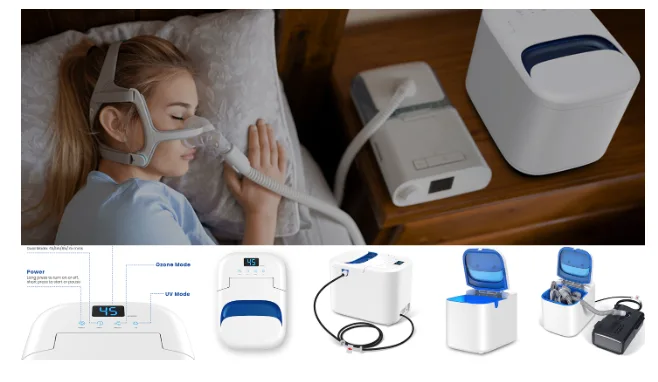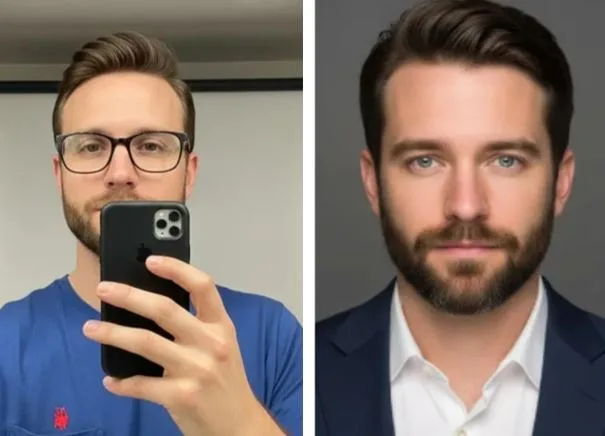Do CPAP Cleaning Machines Really Work? What Sleep Apnea Patients Should Know
For many people living with Continuous Positive Airway Pressure (CPAP) therapy, the standard treatment for Obstructive Sleep Apnea (OSA), the tasks of daily mask fitting, machine maintenance, and regular cleaning can feel like a burden. And in recent years, numerous companies have pitched automated or semi-automated CPAP cleaning machines that promise deep sanitation with minimal effort. But how much of this promise is grounded in evidence? Are these machines really worth the investment? Here’s what you need to know.
Why cleaning your CPAP matters
First, a quick primer: CPAP therapy uses a machine to deliver pressurized air through a mask (or nasal pillows) to keep the airway open overnight. It’s well established that CPAP is highly effective at reducing the breathing interruptions of OSA when used consistently.
Because the mask, tubing, humidifier chamber, and other accessories are in direct contact with your airway, nasal passages, and breath stream each night, they become exposed to moisture, warmth, body fluids (saliva, nasal secretions), and ambient dust and allergens. Over time, without cleaning, components can develop biofilm, mould, bacteria, or simply grime that may compromise comfort, hygiene, or air quality. For example:
- A review found that only 62 % of users had ever cleaned their mask, 52 % cleaned the humidifier chamber, and only 17 % had ever cleaned the hose.
- The respected medical site Harvard Health notes: “if the standing water in a reservoir isn’t cleaned regularly … there is the potential for bacteria or mold to grow, which you could breathe in.”
So yes: cleaning your CPAP components is important for hygienic reasons and for ensuring your therapy remains safe and comfortable.
What CPAP cleaning machines claim to do
CPAP cleaning machines (sometimes called sanitizers or desinfectors) typically advertise that they will:
- Remove or kill bacteria, viruses, fungi, or mould that have colonized the mask, tubing, or humidifier chamber
- Deodorize or freshen the components
- Make cleaning faster, more convenient (often “set-and-forget” overnight)
- Perhaps reduce the risk of infection or respiratory irritation
Most of these devices use one of two main technologies:
- Ozone gas (ozonation), ozone is forced through the tubing/mask to “kill” pathogens
- Ultraviolet-C (UV-C) light or other UV spectrum disinfection parts are exposed to UV to sterilize surfaces
Some machines may combine heat, circulation of air/dryness, or other features.
The market for CPAP cleaning devices is growing: one market research report projects the market will reach nearly USD 293 million by 2030, driven by rising awareness of hygiene and home-based healthcare.
But here’s the key: claims are not always matched by evidence, and regulatory bodies have flagged concerns.
What the evidence and regulators say
Regulatory commentary
The U.S. Food & Drug Administration (FDA) (and other regulatory/sleep-medicine organizations) have issued cautionary statements about CPAP cleaning machines:
- The FDA notes that no home cleaning device for CPAP machines or accessories using ozone or UV light has been cleared or approved by the agency for sanitizing CPAP equipment
- The FDA found that “devices using ozone disinfection generated ambient levels of ozone above limits considered safe for human exposure” and that high concentrations of ozone remained in tubing for even hours after cleaning.
- For example, from 2017-2019, the FDA received reports of cough, difficulty breathing, asthma attacks, headaches, and nasal irritation attributed to ozone-based CPAP cleaning devices.
In short, regulators do not endorse these devices as safe or effective replacements for standard cleaning, and some raise safety alarms.
What clinical/academic reviews say
- A paper on positive airway pressure device care stated that adverse events from ozone disinfection have been documented (including worsening asthma) and that although no adverse events have been reported from UV devices, risks of UV-exposure (skin/eye) exist.
- A review by a sleep clinic noted, “There’s no clinical evidence to support that CPAP cleaners provide a better clean than the traditional method of using soap and water.”
- Healthline summarised that traditional cleaning (soap & water) remains the advised method, and home cleaning machines are “not legally marketed for cleaning purposes” in the case of ozone/UV devices.
So what about effectiveness?
In short, there’s very limited data showing that these cleaning machines have a meaningful clinical benefit (reduced infection rates, better outcomes) beyond standard cleaning. There is, however, some data that they might pose risks (especially ozone-based).
For example, one user’s asthma worsened while using an ozone CPAP cleaner, and improved when discontinuing it. Medical News Today
Therefore, the evidence that paying extra for a dedicated CPAP cleaning machine will meaningfully improve hygiene or health outcomes is weak; the evidence of potential harm (again: especially ozone) is non-trivial. What to know before buying a CPAP cleaner
So… Do CPAP cleaning machines really work?
Here’s a breakdown of what we can conclude, and what we still don’t know:
What we do know:
- Cleaning your CPAP mask, tubing, humidifier chamber, filters, etc, regularly is important for hygiene and comfort. Hand-cleaning with soap & water is effective.
- Some cleaning machines may reduce microbial load on surfaces under controlled lab conditions (though the degree and translation to clinical benefit is unclear). Some manufacturers claim “99.9 % of bacteria eliminated”, though these claims are often manufacturer-based and not always peer-reviewed.
- Ozone-based cleaning machines have documented risks (ozone exposure, residual ozone in tubing, possible lung/airway irritation).
- UV or ozone cleaning machines are not FDA-cleared for CPAP sanitizing as of now; the user must be cautious.
What we don’t know (or where the evidence is thin):
- Whether using a CPAP cleaning machine (versus hand cleaning) leads to fewer infections, fewer respiratory complications, better long-term outcomes, or improved device longevity.
- Whether the cost/benefit ratio is favorable for most users (given the cost of units, supplies, electricity/maintenance).
- Whether any specific brand or technology has robust, independent clinical trials showing superiority over manual cleaning.
- Long-term safety of UV-based devices for CPAP accessories and of residual chemicals/ozone effects.
My verdict:
If you are already diligent about cleaning your CPAP accessories weekly (or more frequently) with soap, warm water, and proper drying, the additional benefit from a CPAP cleaning machine is likely small. If you are not cleaning regularly and you think you’ll use the machine properly (and maintain it as per instructions), then perhaps a machine might reduce your workload, but you must weigh cost and risk, and select a product carefully.
For many users, focusing on consistent manual cleaning is likely the highest-impact step.
What to look for (and what to avoid) in CPAP cleaning devices
When choosing a CPAP cleaning device, prioritize safety, compatibility, and credibility. Look for products supported by independent lab testing that demonstrate effective microbial reduction, and ensure they’re compatible with your specific CPAP mask, tubing, and humidifier model. Clear safety instructionsespecially for ozone or UV-based systemsare essential to prevent exposure risks. Choose a device that’s easy to use, has a good warranty, and offers reliable customer support. Avoid cleaners that make exaggerated claims like “100% sterilization” or suggest replacing traditional soap-and-water cleaning. Steer clear of unverified ozone devices, as they can emit unsafe levels of ozone and damage equipment. In most cases, consistency and proper manual cleaning remain more important than investing in costly or potentially unsafe automated machines.
If you decide to invest in a CPAP cleaning machine, consider these key criteria:
Features you want:
- A device supported by credible independent testing (lab results, peer-reviewed) that shows microbial reduction under real-world conditions.
- Compatibility with your mask, tubing, humidifier chamber, and the type/manufacturer of CPAP you use.
- Clear instructions and safeguards (especially if ozone or UV is used) for how to vent residual ozone, prevent leakage, and ensure safe use. For example, the manufacturer of one large ozone device issued a voluntary recall of the adapter and instructions to reduce ozone exposure. U.S. Food and Drug Administration
- Ease of use, so that you’ll actually use it consistently (if not used, moot).
- Good warranty or customer-service history (sleep-device accessories often need good support).
- Energy‐efficient and a manageable size if you travel or have limited space.
What to avoid / red flags:
- Claims of “100% sterilization” or “eliminates all viruses and bacteria” without independent verification.
- Marketing that implies the device replaces manufacturer-recommended cleaning of mask/hose/filters; note: many CPAP manufacturers still insist on manual cleaning.
- Ozone cleaners that do not provide clear instructions to vent or remove ozone residual. Use has been linked to asthma attacks and respiratory symptoms. AASM+1
- UV devices that expose users (or parts of equipment) to unsafe UV; UV-C can damage plastics and potentially cause skin/eye harm if misused. PMC
- Devices that are very expensive relative to the simplicity of manual cleaning and your own cleaning regimen.
Even if you get a cleaning machine, you cannot skip the basics:
- Daily (or every few days) wash of mask, cushion, humidifier chamber with mild unscented soap, warm water; rinse thoroughly; allow to air dry fully. Harvard Health+1
- Weekly or per manufacturer: wash filters or replace them; inspect tubing for moisture or mould; ensure humidifier water chamber is emptied, dried, and cleaned.
- Replace mask cushions/headgear/tubing at recommended intervals (usually every 3-12 months or sooner if damaged/leaky).
How to decide: Is a CPAP cleaning machine right for you?
Here’s a quick decision tree to help you evaluate if you should invest in a CPAP cleaning device:
- How consistently do you clean your CPAP accessories now?
- If you clean mask, tubing, and humidifier diligently per manufacturer instructions, you’re already doing the high-impact steps. A cleaner might give convenience, but minimal extra benefit.
- If you don’t clean regularly (e.g., you find it tedious, busy, or frustrating), a cleaning machine might help you increase hygiene compliance.
- Do you have any conditions that increase risk?
- If you have asthma, COPD, or other lung issues, you may be more sensitive to residual ozone or chemical exposure from cleaning devices. The FDA has highlighted adverse events in such populations. U.S. Food and Drug Administration+1
- If you have mould or dampness in your home environment, or you share your CPAP with someone else (less common), then hygiene may be more critical.
- What’s your budget and travel/lifestyle needs?
- Some machines cost several hundred dollars; determine if the cost is justified given your usage, the lifespan of your CPAP accessories, and how likely you are to use the machine consistently.
- If you travel frequently with CPAP, look for portable solutions, or consider how cleaning will be managed on the road.
- Will you use it properly?
- Even the best machine requires correct setup (venting, proper mask/tubing attachments, periodical maintenance of the device itself). If the device is misused, it may provide false security.
- Check manufacturer compatibility & regulatory status.
- Does your CPAP manufacturer recommend or allow the use of such cleaning devices? Some mask/hose/manufacturer warranties may be voided if you use unapproved cleaning methods.
- Has the cleaning device been independently reviewed or recall‐checked? For example, one ozone cleaner had a voluntary recall due to ozone exposure risk. U.S. Food and Drug Administration
If, after this evaluation, you conclude that a cleaning machine adds convenience, improves your consistency, and you’re comfortable with the cost and the device’s safety profile, then it may be a rational choice. If not, you’ll likely get nearly equivalent benefit by focusing on disciplined manual cleaning.
Practical steps: best cleaning practices for CPAP users
Whether you choose a cleaning machine or not, here are practical hygiene tips for everyday CPAP care:
- Daily/after each use:
- Detach the mask, headgear, and tubing. Wash the mask shell/cushion and tubing in warm, soapy water (mild unscented soap). Submerge the tubing so water runs through it. Rinse thoroughly. Harvard Health
- If you use a humidifier: empty the water chamber each morning, rinse and allow to air dry (or follow manufacturer for vinegar soak weekly).
- Wipe outside of the CPAP machine and humidifier housing with a damp cloth; never submerge the machine or its power components. U.S. Food and Drug Administration
- Weekly:
- Deep clean humidifier chamber (soak if directed), wash headgear and mask components.
- If you use reusable filters: rinse and dry; if disposable filters, replace per your schedule.
- Inspect tubing for moisture (‘rainout’) and mould; if you notice a musty smell, discontinue use and replace.
- Replacement schedule:
- Mask cushions/headgear: every 3-6 months (or sooner if damaged or you notice wear/leaks).
- Tubing: every 6-12 months (or sooner if visible discoloration, stiffness, or mould).
- Humidifier chamber: if cracked, scratched, or discolored.
- Travel/trip tips:
- Carry distilled water for your humidifier (if required).
- Consider carrying a spare mask or tubing to reduce risk if you can’t clean properly on the go.
- If you can’t wash tubing thoroughly during travel, consider skipping humidifier usage (if your device allows) and reducing mask time until you can clean.
- If using a cleaning machine:
- Follow manufacturer instructions strictly. For ozone devices: ensure proper adapter, venting cycle, never use the machine while CPAP is connected and in use. U.S. Food and Drug Administration
- After cleaning, air out the mask/tubing before use to allow residual ozone/chemicals to dissipate.
- Check your mask and tubing for signs of degradation or silicone breakdown (some cleaning methods may accelerate wear).
- Keep a log of your cleaning machine usage and periodically compare user comfort (e.g., mask comfort/leak/infection symptoms) to when you used manual cleaning only.
Summary: What sleep apnea patients should take away
In summary, CPAP cleaning machines promise easy, automated hygiene for sleep apnea patients, but their benefits are often overstated. While regular cleaning of CPAP masks, hoses, and humidifier chambers is essential to prevent bacteria, mold, and irritation, most medical experts, including the FDA, agree that manual washing with mild soap and warm water remains the safest and most effective method. Ozone- and UV-based cleaning machines, in particular, are not FDA-approved for CPAP sanitation and may pose risks such as ozone exposure or equipment damage. For most users, consistent manual cleaning provides nearly identical results without added cost or potential side effects. However, for those who struggle to clean their CPAP gear regularly, a trusted cleaning machine might offer convenience, provided it’s used correctly and with manufacturer approval. Ultimately, sleep apnea patients should focus on safe, regular maintenance rather than relying on devices with unverified claims. Consulting a sleep specialist before purchasing any cleaning machine can ensure compatibility, safety, and proper care, helping users maintain both effective therapy and long-term respiratory health.





